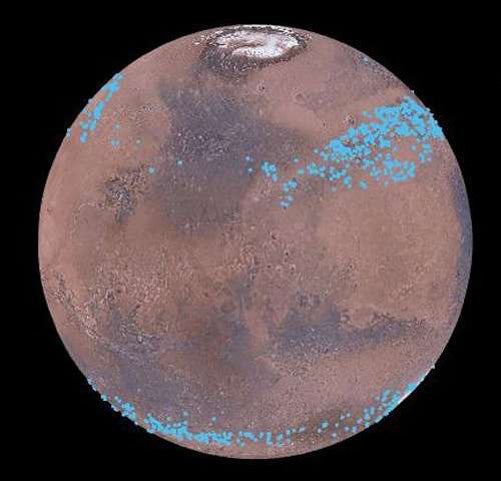Several satellites orbit Mars, and on satellite images, researchers have been able to observe the shape of glaciers just below the surface. For a long time, scientists did not know if the ice was made of frozen water (H2O) or of carbon dioxide (CO2) or whether it was mud. Using radar measurements from NASA’s Mars Reconnaissance Orbiter, researchers have been able to determine that it is water ice. But how thick is the ice, and do the glaciers resemble glaciers on Earth? A group of researchers at the Niels Bohr Institute have now calculated this using radar observations combined with ice flow modeling.
Data combined with modeling
“We have looked at radar measurements spanning 10 years back in time to see how thick the ice is and how it behaves,” said Nanna Bjørnholt Karlsson from the Niels Bohr Institute at the University of Copenhagen. “A glacier is after all a big chunk of ice, and it flows and gets a form that tells us something about how soft it is. We then compared this with how glaciers on Earth behave and from that we have been able to make models for the ice flow.”
Karlsson explained that earlier studies have identified thousands of glacier-like formations on the planet. The glaciers are located in belts around Mars between the latitudes 30° and 50° — equivalent to just south of Denmark’s location on Earth. The glaciers are found on both the northern and southern hemispheres.
From some locations on Mars, scientists have good detailed high-resolution data, while they only have more sparse data from other areas. But by supplementing the sparse data with information about the flow and form of the glaciers from the well-studied areas, astronomers have been able to calculate how thick and voluminous the ice is across the glacier belts.
Could cover the entire planet
“We have calculated that the ice in the glaciers is equivalent to over 150 billion cubic meters [36 cubic miles] of ice — that much ice could cover the entire surface of Mars with 1.1 meters [3.6 feet] of ice. The ice at the mid-latitudes is therefore an important part of Mars’ water reservoir,” said Karlsson.
That the ice has not evaporated out into space could actually mean that the thick layer of dust is protecting the ice. The atmospheric pressure on Mars is so low that water ice simply evaporates and becomes water vapor. But the glaciers are well protected under the thick layer of dust.










